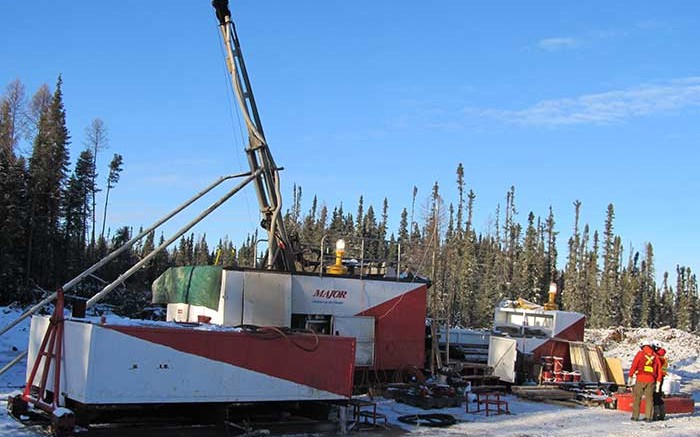Foran Mining (TSXV: FOM; US-OTC: FMCXF) has wrapped up the first round of drilling this year on two deposits near its flagship McIlvenna Bay project in Saskatchewan’s Hanson Lake camp, to see if it could delineate more resources near the large zinc-copper-gold-silver volcanogenic massive sulphide (VMS) deposit.
After Teck Resources’ (TSX: TCK.B; NYSE: TCK) move to extinguish its back-in rights on the nearby Bigstone, Balsam and Hanson properties last October and the release of a positive preliminary economic assessment (PEA) on McIlvenna Bay in November, the junior kicked off a 2015 winter drill program in January. Its goals were to validate the historic resource at the Bigstone deposit and follow up on the high-grade copper discovery on Balsam’s Thunder zone.
“We are a team of geologists. We know VMS deposits do not form in isolation, but rather in clusters that lead to long-lived mining camps like Flin Flon and Snow Lake,” Fiona Childe, the company’s vice-president of corporate development, said in an email.
For that reason, Foran was eager to drill these targets and show that it not only has the encouraging McIlvenna Bay project, but also the “potential to develop a new Canadian base metal mining camp.” (McIlvenna Bay is 65 km west of Flin Flon, Man.)
In 2013, Foran drilled a single hole into a geophysical anomaly found in the Thunder zone, 7 km southeast of McIlvenna Bay. That hole returned 4.1% copper and 0.43 gram gold per tonne over 3.7 metres, including a 1.1-metre interval of 10.6% copper and 0.70 gram gold.
This year the junior followed up on that result, completing 1,900 metres in five holes. In late March, it reported four of the five holes hit thick intercepts of copper- and zinc-rich VMS mineralization, confirming the new discovery near McIlvenna Bay. The best intercepts hit 5% copper, 2.1% zinc, 0.84-gram gold and 41 grams silver over 2.6 metres, and 2% copper, 3.5% zinc, 0.37-gram gold and 12 grams silver over 3.5 metres.
The zone remains open in both directions along strike. Foran is conducting a borehole electromagnetic survey at the Thunder zone to plan the next round of drilling and is searching the Balsam property for other high-grade targets.
As part of the winter 2015 program, Foran drilled 2,550 metres in six holes on the Bigstone deposit, 25 km southwest of McIlvenna Bay. Assays from the initial hole, released in early April, intersected a notably high-grade zone of zinc mineralization. It hit 11.8 metres of 18.4% zinc, including 7.6 metres grading 27% zinc, followed further downhole by 10.6 metres of 1.4% copper and 8.5 metres of 1.3% copper.
This was the first hole drilled in 25 years on Bigstone’s historic resource. The historic estimate includes a copper zone containing 3.8 million tonnes at 2% copper and 0.33-gram gold, and a nearby zinc zone of 530,000 tonnes at 9.6% zinc and 15.9 grams silver. It used cut-off grades of 1% copper and 5% zinc.
Assays from the second hole, reported on April 17, intersected 2% copper over 104.9 metres, including 20.4 metres of 4.1% copper and 19 metres of 3.2% copper.
Once the assays from the remaining four holes at Bigstone are out, the company will start metallurgical test work, with the aim of updating the historic resource to a National Instrument 43-101 compliant resource, Childe says.
Meanwhile, Foran intends to begin optimization studies at McIlvenna Bay. While it hasn’t released details on those studies, it may evaluate adding Bigstone and the Thunder zone as satellite deposits, or it may carry out separate economic studies on the deposits.
“Based on the positive results released to date on the Thunder zone and Bigstone deposit, we are certainly assessing the potential to fast-track one or both of these targets to bring the level of work in line with McIlvenna Bay,” Childe notes.
The 2014 PEA envisions McIlvenna Bay as a 5,000-tonne-per-day underground mining and milling operation with a 14-year life, and start-up costs of $249 million. Annual production should average 59 million lb. zinc, 38 million lb. copper, 16,000 oz. gold and 400,000 oz. silver, at cash costs, net of by-product credits, of negative US37¢ per lb. zinc, or US84¢ per lb. copper. At a 7% discount rate, the project has an after-tax net present value of $262.6 million and a 19% internal rate of return
Mackie Research Capital analyst Peter Campbell writes that based on Hudbay Minerals’ (TSX: HBM; NYSE: HBM) experience mining VMS deposits in the Flin Flon camp, that projects often turn out to be 2.5 times bigger in size than when mining first starts. Given the junior’s recent success at Bigstone and Thunder, he believes Foran’s asset base will grow. He has a 12-month target of 35¢ a share and a speculative “buy” on the stock.
M Partners analyst Derek Macpherson believes Foran’s exploration results to date — combined with its zinc exposure, favourable jurisdiction and proximity to infrastructure — will likely make it attractive to multiple suitors, including Hudbay. He rates Foran as a “buy,” with a 45¢ target.


Be the first to comment on "Foran finds promising results at the Hanson Lake camp"